The Birth of the California Art Club: Its Founding and First Annual Exhibition
© By Eric J. Merrell, CAC Historian
From the Spring 2009 CAC Newsletter
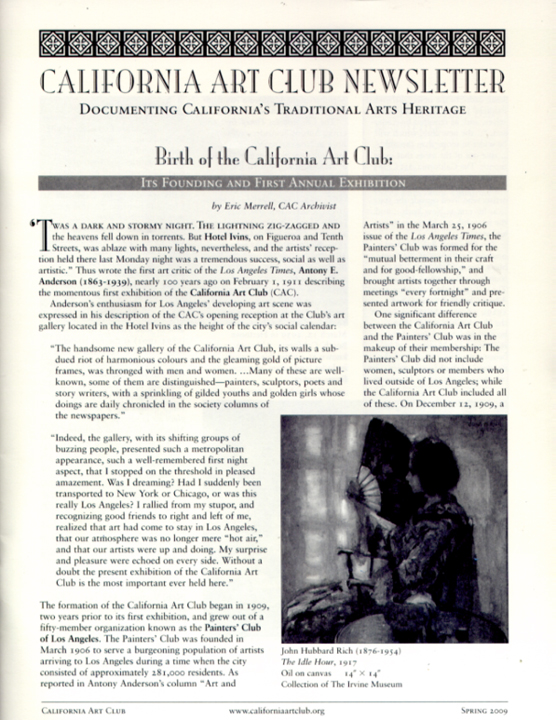
Spring 2009 CAC Newsletter
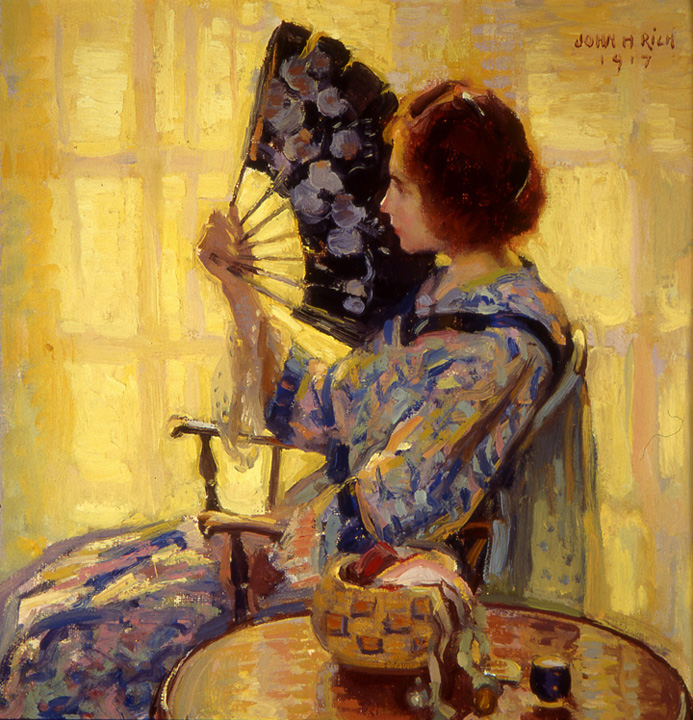
John Hubbard Rich (1876-1954), “The Idle Hour,” 1917; o/c, 14″ x 14″, Collection of the Irvine Museum
“Twas a dark and stormy night. The lightning zig-zagged and the heavens fell down in torrents. But Hotel Ivins, on Figueroa and Tenth Streets, was ablaze with many lights, nevertheless, and the artists’ reception held there last Monday night was a tremendous success, social as well as artistic.” Thus wrote the first art critic of the Los Angeles Times, Antony E. Anderson (1863-1939), nearly 100 years ago on February 1, 1911 describing the momentous first exhibition of the California Art Club (CAC).
Anderson’s enthusiasm for Los Angeles’ developing art scene was expressed in his description of the CAC’s opening reception at the Club’s art gallery located in the Hotel Ivins as the height of the city’s social calendar: “The handsome new gallery of the California Art Club, its walls a subdued riot of harmonious colors and the gleaming gold of picture frames, was thronged with men and women…Many of these are well-known, some of them are distinguished – painters, sculptors, poets and story writers, with a sprinkling of gilded youths and golden girls whose doings are daily chronicled in the society columns of the newspapers.”
“Indeed, the gallery, with its shifting groups of buzzing people, presented such a metropolitan appearance, such a well-remembered first night aspect, that I stopped on the threshold in pleased amazement. Was I dreaming? Had I suddenly been transported to New York or Chicago, or was this really Los Angeles? I rallied from my stupor, and recognizing good friends to right and left of me, realized that art had come to stay in Los Angeles, that our atmosphere was no longer mere “hot air,” and that our artists were up and doing. My surprise and pleasure were echoed on every side. Without a doubt the present exhibition of the California Art Club is the most important ever held here.”[1]
The formation of the California Art Club began in 1909, two years prior to its first exhibition, and grew out of a fifty-member organization known as the Painters’ Club of Los Angeles. The Painters’ Club was founded in March 1906 to serve a burgeoning population of artists arriving to Los Angeles during a time when the city consisted of approximately 281,000 residents. As reported in Antony Anderson’s column “Art and Artists” in the March 25, 1906 issue of the Los Angeles Times, the Painters’ Club was formed for the “mutual betterment in their craft and for good-fellowship,” and brought artists together through meetings “every fortnight” and presented artwork for friendly critique.[2]
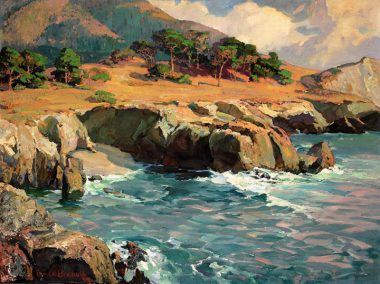
Franz Anton Bischoff (1864-1929), “Carmel Rocks at Sunset;” o/c, 30″ x 40″, Paul and Kathleen Bagley Collection
One significant difference between the California Art Club and the Painters’ Club was in the makeup of their membership: The Painters’ Club did not include women, sculptors, or members who lived outside of Los Angeles; while the California Art Club included all of these. On December 12, 1909, a small cadre of the newly disbanded Painters’ Club reorganized themselves, and, as reported by Anderson, “…the new club, which will be wider in scope that the old,” rose out of the ashes that same month. The California Art Club’s membership guidelines were broadened to include women as well as artists who lived outside the state – as far east as New York – and the new club grew quickly in size and stature.[3]
The Painters’ Club also had predecessors, beginning with the Rambler’s Sketch Club (circa 1881), founded in Richmond, Indiana.[4] The self-taught Indiana-born artist, Albert Clinton “Pops” Conner (1848-1929), was one of the founders of the Sketch Club, which later metamorphosed into the Richmond Art Association (founded 1898, but had exhibited artwork in local schools as early as 1896) and then became an integral part of the Richmond Art Museum.[5] After Conner moved to California he became the first President of the Painters’ Club of Los Angeles and was also later elected an Honorary Member of the California Art Club, as well as being an active exhibitor.[6]
Antony Anderson was born in Norway on May 1, 1863. He studied painting at the Art Students League in New York City and at the Art Institute of Chicago under George de Forest Brush (1855-1941) , Gari Melchers (1860-1932), and Frederick W. Freer (1849-1930). He was at one time associate editor of Boys World. Upon moving to Los Angeles in 1903, he came the first art critic for the Los Angeles Times, and worked in that post for twenty-three years, eventually relinquishing his position to British-born artist and art critic Arthur Millier (1893-1975) in 1926. Anderson died on March 12, 1939 in Hermosa Beach, California. Although mainly known as a critic, his artwork includes landscapes, portraits, and figure studies.
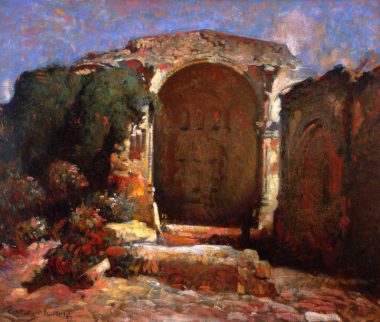
Charles Percy Austin (1883-1948), “San Juan Capistrano Mission,” 1927; o/c, 30″ x 36″, Collection of The Irvine Museum
During his tenure at the Los Angeles Times, Anderson was a diligent recorder of city life and cultural events in the young metropolis, commonly including the titles and vivid descriptions of the artwork on view. Although there exists no record of a first meeting[7] of the California Art Club, in his article describing the demise of the Painters’ Club of Los Angeles, Anderson revealed in the next paragraph that there would be a successor “to be called the California Art Club.” He informed readers that Charles Percy Austin (1883-1948) would be Secretary and Frank Rennsselear Liddell (1864-1923) would serve as the first President.[8] Austin was a student of John Henry Twachtman (1853-1923) at the Art Students League in New York and is today renowned for his paintings of Mission San Juan Capistrano. Liddell, originally from Wisconsin, settled in Los Angeles in 1883 where he was a banker and self-taught plein-air landscape painter. Although Anderson continued his weekly column throughout this period, the next mention of the CAC wasn’t until February 1910.
Despite the brief lapse in coverage, the CAC had been busy. When we next hear about the young club, Anderson reported on their second meeting, held at Franz Bischoff’s studio at 320 Pasadena Avenue, Pasadena (now South Pasadena) on the 5th of February. At this meeting seven new members joined the group. Both John Hubbard Rich (1876-1954) and Robert Leicester [Rob] Wagner (1872-1942) joined as Active Members. Mauritz de Haaff (1877-1948), Allen Durand (1865-1939), William A. Matern (1867-1923), Frederick Roland Miner (1876-1935) and Jack Wells enlisted as Associates. In addition to the new members there were four others present who apparently were already members; they were Franz Anton Bischoff (1864-1929), Carl Oscar Borg (1879-1947), Aaron E. Kilpatrick (1872-1953) and William Wendt (1865-1946).[9] Bischoff, Borg, and Wendt are probably familiar to the reader. However, Aaron Kilpatrick, who may be less well-known, was also an artist of merit.
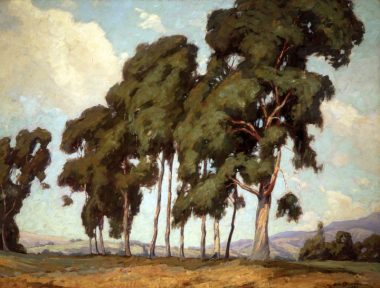
Aaron Kilpatrick (1872-1953), “Eucalyptus Trees,” 1909; o/c, 36″ x 48″, Collection of The Irvine Museum
Born in 1872 in St. Thomas, Canada, Kilpatrick was educated in the public schools of Winnipeg and moved to the United States in 1892. He had settled in southern California in 1907 where he established a successful commercial art business. He studied with William Wendt and often accompanied him on month-long painting excursions. When he was fifty years old, Kilpatrick sold his business and devoted the rest of his life to painting fine art. He received national acclaim as a fine artist and was elected an Associate of the prestigious National Academy of Design. Also at the second meeting of the California Art Club, a constitution similar to that of the Chicago-based Society of Western Artists (est. 1896) was adopted to gain prominence for the artists and to allow travelling exhibitions. A permanent exhibition committee was established, consisting of Wendt, Wagner, Bischoff, Borg and Austin.[10]
By the end of its second month, the Club elected their first Honorary Members, they were Antony Anderon, Hector Alliot (1862-1919) and Everett C. Maxwell. Alliot was an internationally-known art critic, director of the Southwest Museum, and the first art history professor at the University of Southern California. Maxwell was a popular western fillm writer, whose works include the 1925 silent version of Northern Code and the 1928 film, The Old Code.[11] The membership then numbered approximately sixteen.[12] The next few monthly meetings were held at various locations in the Los Angeles area, including at members’ homes and studio, Kanst Gallery and Blanchard Hall.
On July 16, members of the CAC exhibited their works in the First Annual Art Exhibit of the Chautauqua Association of Southern California, which opened in the galleries at the Long Beach Public Library and continued through September 15, 1910 with free admission to the public. This was a multi-group exhibition which consisted of sixty-three pictures,[13] with one wall dedicated to work by CAC members. This was the first time members of the CAC exhibited together and was acknowledged as a group since the club’s formation about eight months prior. Five new members appeared for the first time in the exhibition: Benjamin Chambers Brown (1865-1942), Valentine J. “Val” Costello (1875-1937), Hanson Duvall Puthuff (1875-1972), John [Jack] Wilkinson Smith (1873-1949)[14] and Julia Bracken Wendt (1868-1942).[15]
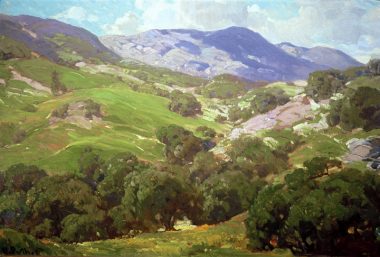
Hanson Puthuff (1875-1972), “Topanga in the Spring;” o/c, 24″ x 36″, Collection of The Irvine Museum
here is a possibility that Julia Wendt was also a founding member of the CAC, probably along with her husband William, and may have had a hand in the demise of the Painters’ Club. The men-only Painters’ Club had, on at least two occassions (Aug. 24 and Dec. 8, 1908; PC Minutes), visited the Wendt house and admired the works of both Julia and William. Although only William was a member, Julia was exhibiting just as frequently as her husband and probably more frequently than many of the other Painters’ Club members. In Anderson’s December 12, 1909 column, he made a comment about women in the new CAC: “Apparently women will not be debarred from membership in the new club. But will they really be admitted? They certainly won’t stay out if there’s a loophole for getting in.” This seemingly negative comment provoked two letters to the Editor of the Los Angeles Times. Along with a “Lydia Pinkham” (Anderson didn’t believe this to be the author’s real name) whose letter was reproduced in Anderson’s column of January 9, 1910 (The Ladies Once More), Julia Wendt wrote a letter to Anderson that was reprinted in the December 26, 1909 column (An Open Letter), taking issue with Anderson’s comments and strongly supporting women artists. Although we don’t know what provoked Anderson to make the comment, it is interesting to note that this exchange took place within the first two weeks after the CAC had supplanted the Painters’ Club. Years later, Julia was “introduced as [a] pioneer member” of the California Art Club at a 1932 party held at the CAC’s Clubhouse, the Frank Lloyd Wright designed Hollyhock House, as recorded in the August 1932 issue of the CAC Bulletin.[16]
A little more than four months after the Chautauqua Association exhibit, the California Art Club opened their first Annual Exhibition on January 30, 1911 to great acclaim in the California Art Club Gallery and Club-Room, located in the Hotel Ivins in Los Angeles: “All [of] this is [a] performance well worth taking note of, for it means that our prophecies are coming true, that Los Angeles is really becoming an art center – and that from today it is up to us to make our work keep pace with our abilities,” wrote Antony Anderson.[17]
The CAC has a fascinating history and has experienced many twists and turns and ups and downs. The California Art Club of the present is now kicking off three years of centennial celebrations. From 2009 through 2011 the Club’s two “100-year” anniversaries include the founding of the Club in 1909 and its first major exhibition held in 1911. In many ways the CAC has never been in better shape than it is today. The founders would be pleased to know that today the California Art Club has a membership of more than 2,000 artists and patrons, as well as offices with four full-time employees and four consulting staff members, many dedicated volunteers and committees, and a new research art library. In addition, the Club has Chapters in San Diego, Orange County, Malibu/Ventura County, Santa Barbara and San Francisco. The Club is exhibiting members’ works continuously at the California Art Club Gallery at The Old Mill in San Marino, the Blinn House in Pasadena, and at the Los Angeles Chamber of Commerce, as well as curating exhibitions at numerous museums. To celebrate the Centennial, the CAC announced a logo competition open to all members and a book based on the history about the first 100 years of the CAC is currently underway. Indeed, as Antony Anderson remarked nearly 100 years ago, “…art [has] come to stay…”
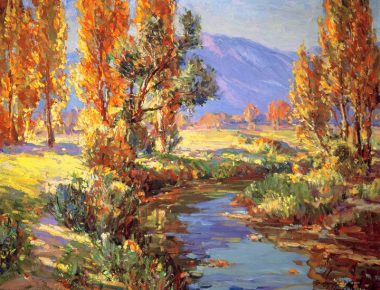
Benjamin Brown (1865-1942), “Autumn Glory;” o/c, 25″ x 30″, Collection of The Irvine Museum
[1] Antony Anderson, California Art Club, Los Angeles Times, February 1, 1911 (All of Anderson’s columns were published under the “Art and Artists” title. I have used the subtitles here in citing specific sections within each weekly column.)
[2] Antony Anderson, The Painters’ Club, Los Angeles Times, March 25, 1906, VI2
[3] Ibid.
[4] Conner and his brother Charles Conner (1857-1905), along with Frank Joseph Girardin (1856-1945) and Micajah Thomas Nordyke (b. 1847), founded the Rambler’s Sketch Club and soon added John Elwood Bundy (1853-1933) to their group. Another group by the same name was founded 1914 in Washington, D.C., by Charles H. Seaton (1865-1926), Winfield Scott Clime (1881-1958) and Edwin H. Cassedy; they soon included Benson Bond Moore (1882-1974) and later August H. O. Rolle (1875-1941), Edgar Hewitt Nye (1879-1943), and Henry Hobart Nichols, Jr. (1869-1962). This group later became the Washington Landscape Club in 1920. )
[5] Email to author from Shaun Dingwerth, Executive Director of the Richmond Art Museum, Sept. 11, 2008; http://www.AskART.com
[6] Antony Anderson, The Painter From Indiana, Los Angeles Times, May 7, 1911, pg. III22 2
[7] We can infer from the other known meetings that a first meeting probably took place on or around Jan. 5, 1910 at an unknown location. There were four other artists present at the second meeting (referred to as such by Anderson) on Feb. 5, 1910 who weren’t mentioned in Anderson’s Dec. 12, 1909 article along with Liddell and Austin, so they must have joined at some point in between. At least initially, meetings took place on the 5th of the month.
[8] Antony Anderson, Exit the Painters’ Club, Los Angeles Times, December 12, 1909, III17
[9] Antony Anderson, California Art Club, Los Angeles Times, Feb. 13, 1910, III11
[10] Ibid.
[11] Though he wasn’t a member of the Painters’ Club, Maxwell appears in their Minutes of Oct. 19, 1909: Mr. Everett Maxwell, who was “furnished gratuitously by Mr. Blanchard,” was to serve as Curator for the Second Annual Exhibition of the Painters’ Club, held at Blanchard Art Gallery.
[12] The Anderson column begins by saying that the club “has decided to enlarge its membership, and has sent invitations to many of the prominent painters and sculptors in Los Angeles and Pasadena to join the new organization.” Though producing unknown results, this could have included Ralph F. Mocine, Benjamin C. Brown and others who appear with the club shortly afterwards. (Antony Anderson, Art Notes, Los Angeles Times, Feb. 27, 1910, III14)
[13] Only 53 works are listed; also, some CAC member names are undecipherable in the article.
[14] John W. Smith and Jack W. [Wilkinson] Smith appear to be the same person – during his years with the PC and early in the CAC he went by “John,” later going by “Jack.” In fact, the Painters’ Club roster lists “John Smith, c/o Varney + Green [Billboards], San Pedro” – the faintly inscribed “John” is crossed out and boldly rewritten “Jack.” Jack W. Smith also later worked for Pacific Outdoor Advertising during the Depression. (Edan Hughes, Artists in California 1786-1940, Vol. II, p.1036)
[15] Originally, the opening was July 8 and the venue was to be “the beautiful galleries of the Carnegie library.” Both of these were subsequently changed. (Antony Anderson, Coming Exhibition, Los Angeles Times, June 12, 1910) Many of the other exhibitors in the Chautauqua exhibition – listed by Anderson specifically as not belonging to the CAC, as he reviewed CAC work and non-CAC in two separate columns – eventually became CAC members in the following years. Some were even early members of the Painters’ Club – William Swift Daniell (1865-1933), Norman St. Clair (1863-1912) and possibly “W. E.” (W. A.?) [William Alexander] Sharp (1864-1944). They too will eventually join the CAC. (Antony Anderson, Exhibition at Long Beach, Los Angeles Times, July 24, 1910, III11; Antony Anderson, At Long Beach, Los Angeles Times, July 31, 1910, III14;)
[16] Gage Cuts the Cake, CAC Bulletin, Aug. 1932, Vol. VII, No. 8
[17] California Art Club, Los Angeles Times, February 1, 1911; op. cit.


